The difference between hydroxypropylmethylcellulose and hydroxyethylcellulose
Q1
The characteristics of
hydroxypropyl methylcellulose, which appears as white or similar white fiber powders or particles, are non-ionic components in cellulose mixtures. It is a semi-synthetic inactive viscoelastic polymer.
Hydroxyethyl cellulose is a white or yellow odorless, non-toxic fiber or solid powder, and its raw material is obtained by etherification of alkaline cellulose and ethylene oxide. It is a nonionic soluble cellulose ether.
Q2
Differences in application fields
In the field of coatings, hydroxypropyl methylcellulose has shown excellent dissolution properties, not only as a thickener and dispersant, but also as a stabilizer. It can easily dissolve in water or organic solvents. In addition, PVC also has its unique application in the coating industry, and it is often used as a paint remover to support the process of preparing PVC by suspended polymerization. At the same time, polyvinyl chloride has a wide range of uses in many industries such as leather, paper products, fruit and vegetable preservation, and textiles.
On the other hand, hydroxypropyl methylcellulose also plays a key role in many other fields. For example, it is almost insoluble in solvents such as anhydrous ethanol, ether, acetone, etc., but it can quickly dissolve in transparent or cloudy colloidal solution in cold water. Because of this, it is widely used in coatings, inks, fibers, dyeing, papermaking, cosmetics, pesticides, mineral processing, petroleum recycling and pharmaceutical industries.
Q3
Different solubility
hydroxypropyl methylcellulose is almost insoluble in solvents such as anhydrous ethanol, ether, acetone, etc., but it can quickly dissolve in transparent or slightly turbid colloidal solution in cold water. In contrast, hydroxyethyl cellulose (HEC) can prepare solutions with different viscosity ranges and exhibit good salt-soluble properties for electrolytes.




